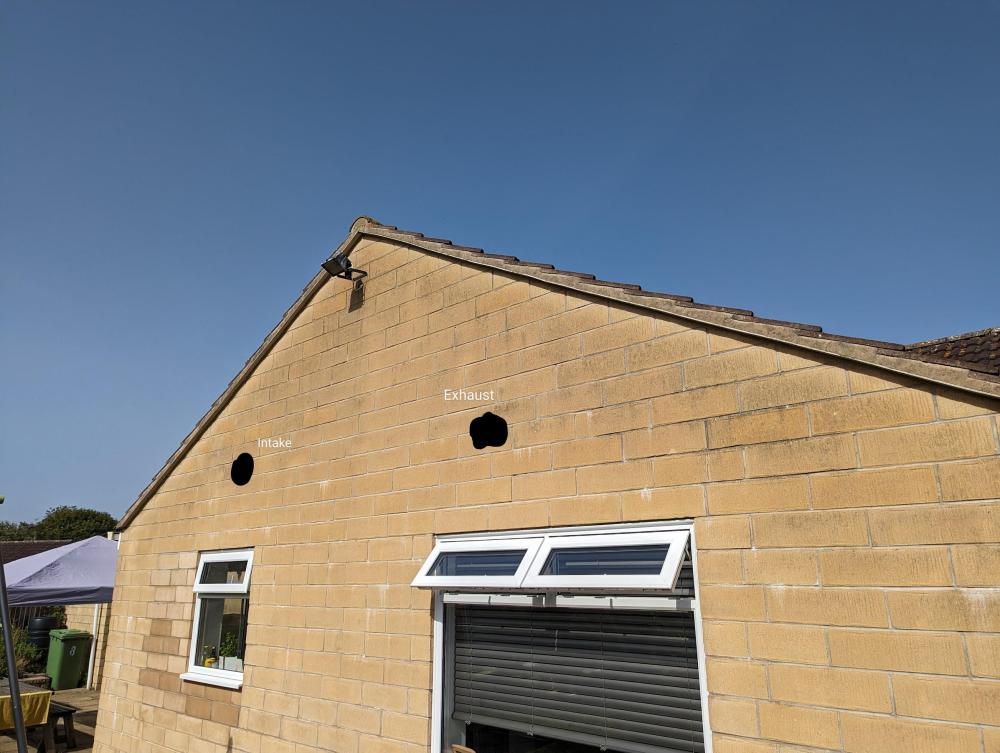-
Posts
9 -
Joined
-
Last visited
Personal Information
-
Location
Frome
Recent Profile Visitors
The recent visitors block is disabled and is not being shown to other users.
Jim K's Achievements

New Member (2/5)
7
Reputation
-
The intake and exhaust will indeed be on the same southerly wall, so they are out of prevailing wind... but I look at the news and see storms across northern Europe and think, "hmm what will be a problem for me if/when that comes here?". My garage roof is surely toast, my solar panels are a small risk, but the MVHR is an unknown. Regardless of how well sealed a property is, a 100mph gust over the external vents will create a big momentary pressure drop vs inside. I guess that will be ok-ish, but there's a high chance it could also cause a significant pressure difference between the intake and exhaust because they are separated by ~2m but within 2m of the building edge, so swirling wind vortexes will surely do "stuff". I'm sure it's not a major concern but I'm just about to install it so I like the idea from @ToughButterCup of some sort of a wind break. I was considering a brise soleil with solar panels on it just under these vents to shade the windows. They'd have an air gap at the back to avoid hot air interfering with the vents, so with a bit of over-engineering 😄 I may be able to bolt some extra protection there, or even raise the sun break above the vents 🤔 EDIT here's a pic... It's all a bit close together because "bungalow" but this is honestly the only place the unit can go. There's about 2m between the vents, 1m diagonally from the roof. I might move it in 5+ years if we do build a small extension on the other side of the house, but for now once installed those kitchen windows will mainly be shut. I guess that brise soleil would be toast long before the MVHR in this situation 😂
-
I live on a hill where the wind is generally stronger and, as we see from global news, the weather is getting crazier... So I was wondering: What happens to the ducting and MVHR when the house is hit by 80, 100, 120+ mph winds? Do joints pop apart or damage caused by big pressure differentials? One mitigation could be a pressure release valves on the intake and exhaust ducts. A spring would keep it shut but if a sudden gust comes it would let air out of the duct to reduce pressure. Had anyone heard of any issues caused by storms or even hurricanes?
-
I've gone with the mid range Vent Axia Sentinel Kinetic. Only £899 in the Air Shop sale and good support, parts and usage across the UK and Europe. Those fancy units aren't worth it for my retrofit - and most will not go through my loft hatch. Everything should be about £2k all in, including core drill bits etc. I'll be installing mine starting as soon as the ducting arrives from BCP, ideally will have it in by end of September. Another bunch of hours in the loft, yay... I hate it up there 😅
-
Jim K changed their profile photo
-
So, to summarise this thread (and much of this MVHR forum area tbh): MVHR is a great enhancement to many homes that are reasonably well sealed -- the benefits can be great even for less airtight properties due to fresh air and significant humidity reduction, with all the associated benefits of those. There are rooms in many houses that don't have enough ventilation, or even any windows. So opening doors and windows aren't necessarily a solution, especially in winter. Don't buy expensive units and ducts unless you're chasing that last few watts here and there for very high performing properties. For retrofit, cheaper units and eBay are your friend. Use it how you want -- turn it off, up, or down whenever you feel like. But Passivhaus properties are designed around it so expect some consequences. Use windows and doors as you see fit - you have the flexibility. But probably don't turn the unit off with all the windows shut for extended duration. Make it smart if you can, or just ignore it and let it do its thing. Humidity is cheap and easy to measure and a good proxy for CO2 and other air quality issues. Right?
-
I also want to minimise the MVHR running when there's less of a reason for it to be on -- e.g. windows/doors open, smells or bonfires outside. And, when humidity is low or we're out, I want the system to spin down to low or turn off for a while. So, I have a 4 channel wifi controller attached to my Vent Axia Sentinel Kinetic BH that allows me to use Home Assistant (and Google) to switch from auto to any of low, normal, boost of turn it off, and back. I plan to add some automatons that use temp/humidity data from the Tado radiator valves, door and window sensors and weather forecast to override the auto-boosting humidity sensor when it's appropriate. The goal is to maximise comfort and minimise power usage, plus generally allow anyone at home to say "hey google, turn off the ventilation" when the local farmer inevitably spreads a bunch more poop on the fields, as he does at least once a month. In my retrofit bungalow I don't have to be super-concerned about a few hours or even a day without the system running as it's draft free but not ultra-airtight.
-

Insulating the unit in a cold loft?
Jim K replied to Jim K's topic in Mechanical Ventilation with Heat Recovery (MVHR)
I've gone with somewhere between option 1 (just put it on shelf/wall) and option 2 (loosely insulated box)... Once it's in place in the loft and proven to work, i'll put some extra loft or duct insulation over the top of it all to protect the unit from excess heat from the roof in summer, and keep it a bit warmer in winter. Anything more complex and it risks being hard to access the unit if ever needed for anything more than a filter change. -
I'm soon about to retrofit a Vent-Axia Sentinel Kinetic BH to my bungalow, so it'll be going into a cold loft. I have an opportunity to build an osb box to hold and contain the unit, and there's an option to make it a bit larger I can also add insulation. I'm getting conflicting advice from forums, Vent-Axia technical and the manual that comes with it as to whether I should, and if it's worth it. I want to get as close to the 90% claimed heat recovery as possible, so it seems there are 3 options: 1. No insulation: AKA "it doesn't need it, just do the ducts", put it on a shelf in the loft and forget about it. 2. Build a box & loosely insulate: cut neat holes for the ducts and stuff loft insulation around the unit, but leave small gaps for it all to breathe in case the unit "sweats". 3. Build a box and SEAL it: Celotex, tape, make it tight with no air gaps for maximum heat retention - but also no airflow for any dampness that might creep out. If it was your house what would you do? Is condensation (other than the condensate pipe) something to consider?
-

MVHR Condensate Drain
Jim K replied to richo106's topic in Mechanical Ventilation with Heat Recovery (MVHR)
Just to add to all this... In my bungalow I don't have a decent route in the loft to get to a drain or an outside gutter, so I've bought a Grundfos condensate pump for £80. Although this sounds like overkill, it will allow me to run the tube to a soil stack 12m away over an obstacle course, or go out the wall to the downpipe of a gutter. No dry traps, hardly any pvc pipes or insulation. It also allows the overfill interlock relay on the pump to stop the MVHR unit automatically if there's an issue. It'd be good to not need a pump but in my case there's no avoiding it. It'll only be used for a few months of the year and should stay unfrozen under the loft insulation.




